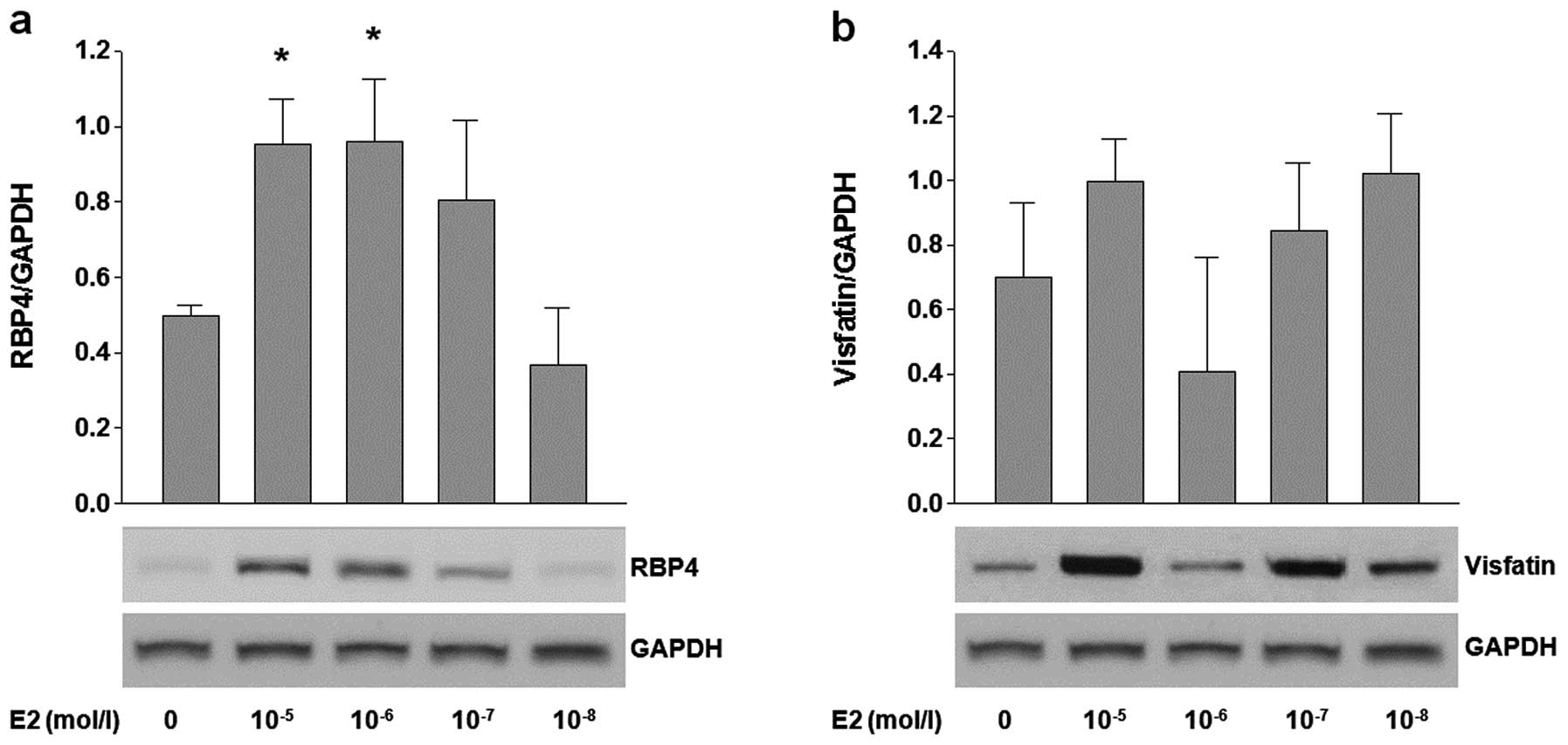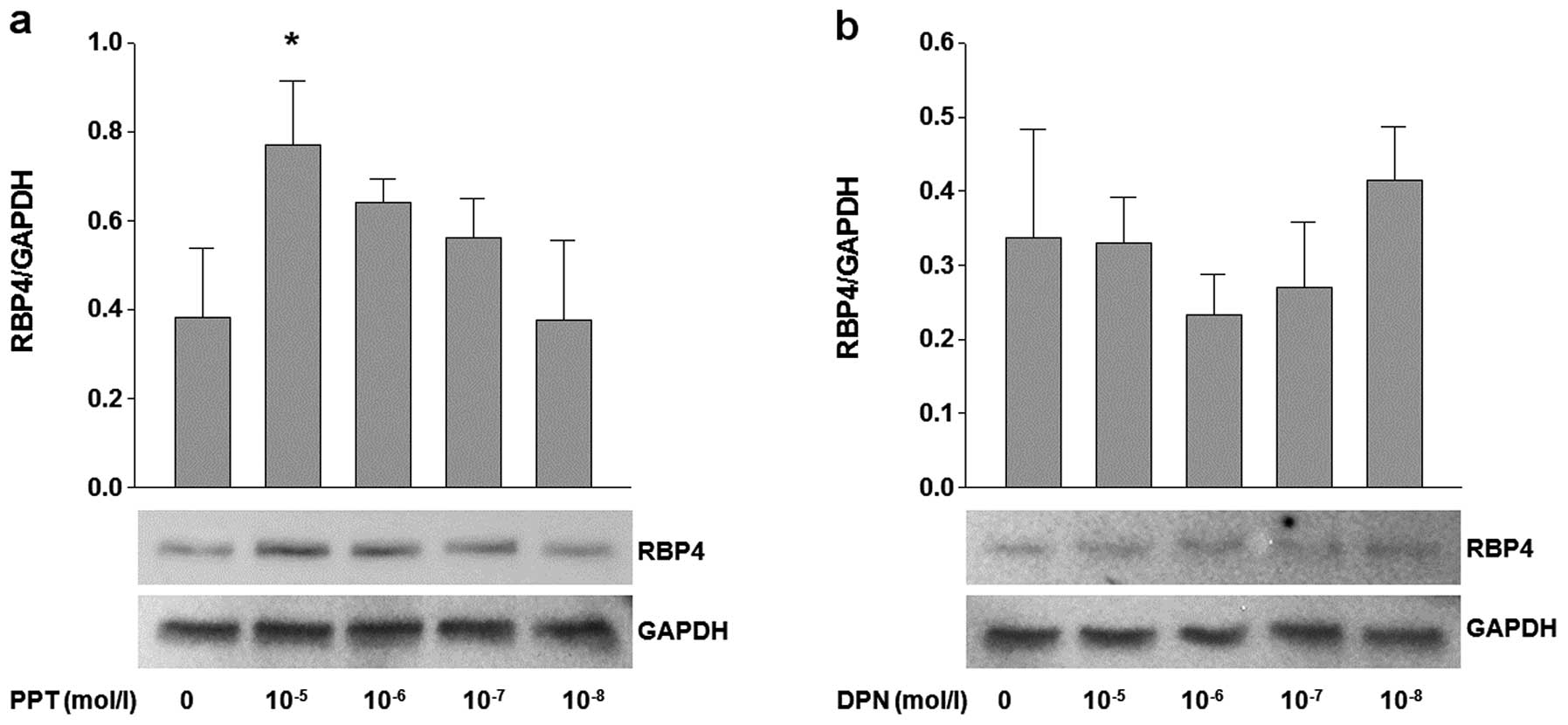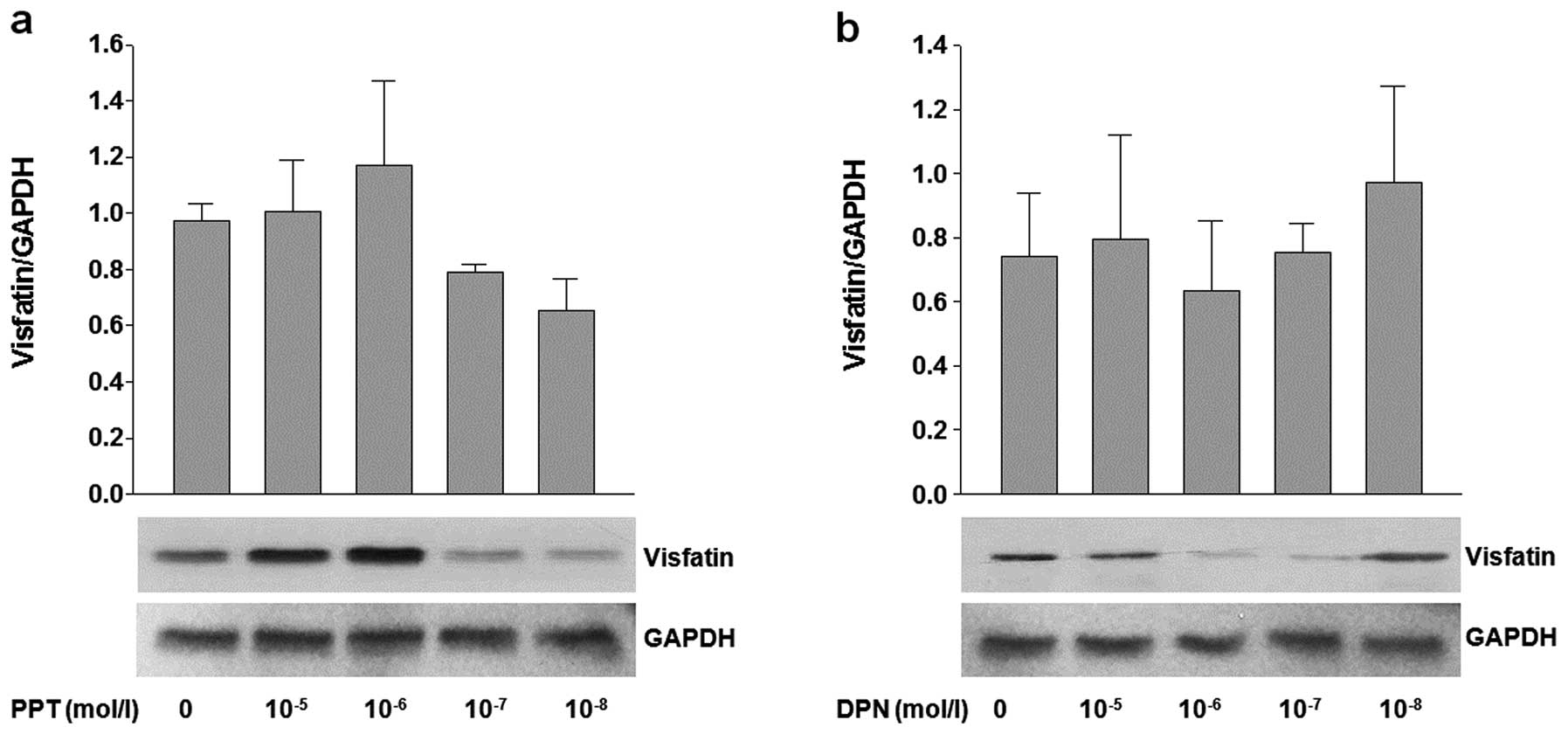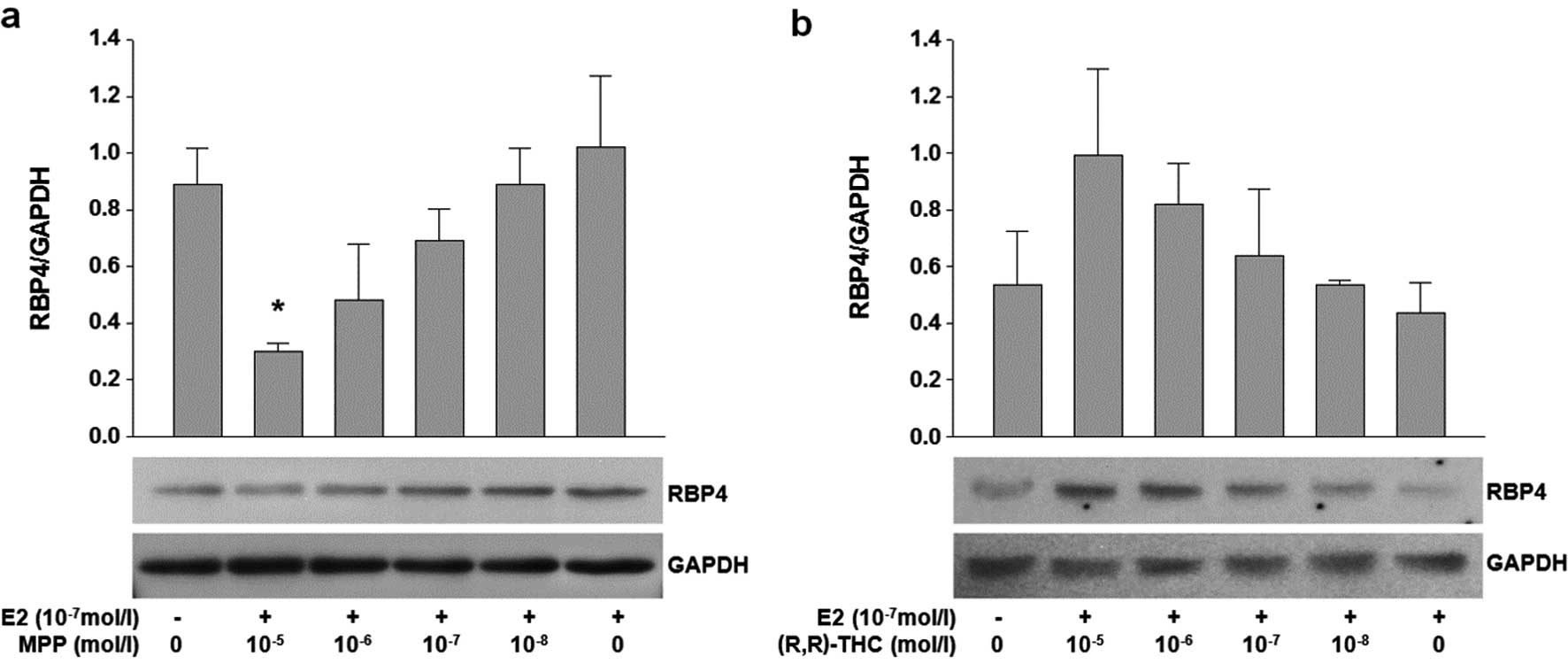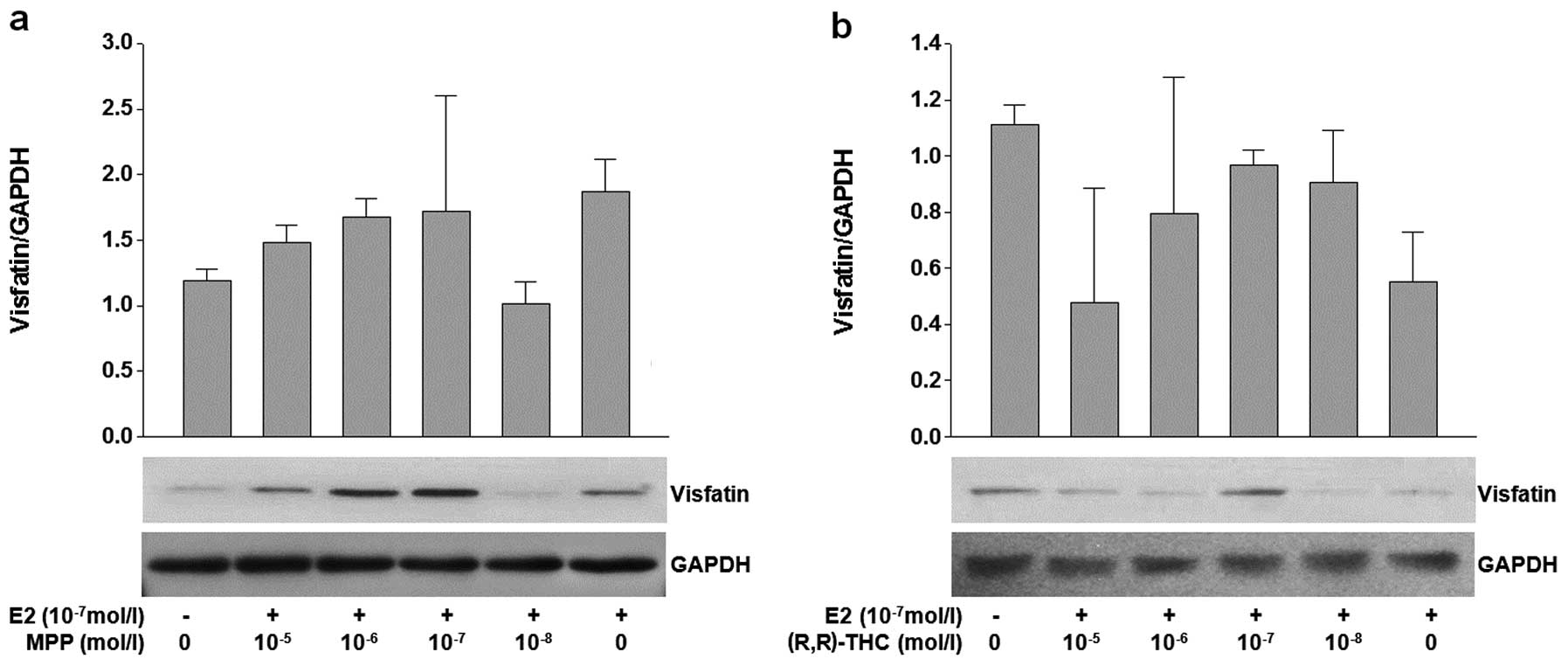Effects of estrogen receptor α and β on the expression of visfatin and retinol-binding protein 4 in 3T3-L1 adipocytes
- Authors:
- Published online on: July 12, 2013 https://doi.org/10.3892/ijmm.2013.1440
- Pages: 723-728
Abstract
Introduction
Adipose tissue is not only a simple energy store, but is increasingly being recognized as an important organ in the regulation of metabolism and pathological processes. Adipokines are a series of soluble factors secreted by adipose tissue. There are several known types of adipokines, such as relatively well known leptin, adiponectin, interleukin-6 and resistin, as well as visfatin and retinol-binding protein 4 (RBP4) (1–3). Visfatin is a 52-kDa cytokine secreted by visceral fat and its expression level in plasma increases with the severity of obesity. Visfatin exerts insulin-mimetic effects and its plasma levels increase in overweight and obese patients with metabolic syndrome (2,4). RBP4 was initially thought to function only in the delivery of retinol to tissues (5). However, the transgenic overexpression of human RBP4 causes insulin resistance and glucose intolerance through a retinol-independent mechanism, whereas the normalization of serum RBP4 induces insulin sensitivity. In obese patients with type 2 diabetes mellitus, serum levels of RBP4 are increased (1,6). Substances involved in the regulation of adipokine expression in adipocytes are currently being investigated. Such substances may participate in energy elevation, sugar or lipid metabolic processes and the overall process of obesity within the body.
Estrogen deficiency during menopause causes excessive visceral adipose tissue accumulation which is known to be linked to metabolic syndrome (7). Loss of ovarian function is related to both an increase in total fat and an accumulation of central fat, which increases the risk of cardiovascular and metabolic disease (8–11). Adipose tissue metabolism is directly influenced by sex hormones, particularly estrogen, and the estrogen receptor (ER) is expressed at the mRNA and protein level in human adipose tissues (12). ERα and ERβ are both expressed in adipose tissue and bind estrogen with different affinities (13,14). The physiological role of ERβ appears to be a modulator of ERα activity in vitro (15). However, very little is known about the effects of the two subtypes of ERs on the expression of visfatin and RBP4.
In this study, we aimed to demonstrate the effects of estrogen via ERs on visfatin and RBP4 expression by manipulating the concentration of estradiol (E2) and ERα- and β-selective agonists and antagonists in 3T3-L1 adipocytes.
Materials and methods
Materials
We used 17β-estradiol (1,3,5[10]-estratriene-3, 17β-diol, cell culture tested) purchased from Sigma (St. Louis, MO, USA). The ERα selective agonist, 4,4′,4″-(4-propyl-[1H]-pyrazole-1,3,5-triyl)trisphenol (PPT), the ERβ selective agonist, 2,3-bis(4-hydroxyphenyl)-propionitrile (DPN), the ERα selective antagonist, 1,3-bis(4-hydroxyphenyl)-4-methyl-5-[4- (2-piperidinylethoxy)phenol]-1H-pyrazole dihydrochloride (MPP), and the ERβ pure antagonist and partial ERα agonist, (5R, 11R)-5,11-diethyl-5,6,11,12-tetrahydro-2,8-chrysenediol [(R,R)-THC], were purchased from Tocris Bioscience (Ellisville, MO, USA). Anti-mouse RBP4 and anti-mouse visfatin antibodies were obtained from R&D Systems (Minneapolis, MN, USA). Anti-GAPDH antibody was purchased from Bio-Rad Laboratories (Hercules, CA, USA).
Cell culture
Mouse 3T3-L1 fibroblasts (American Type Culture Collection, Manassas, VA, USA) were plated at 5×104 cells in Dulbecco’s modified Eagle’s medium (DMEM) supplemented with 25 mM glucose, 10% fetal bovine serum (FBS), 500 units/ml penicillin and 500 μg/ml streptomycin (medium A) at 37°C in a 5% CO2 humidified atmosphere. The cells were grown in the same medium until three days after confluence and were then differentiated into mature adipocytes by treatment with 500 μM 3-isobutyl-1-methylxanthine (IBMX), 250 nM dexamethasone and 330 nM insulin in medium A. The cells were then incubated for two days in medium A containing 330 nM insulin, followed by four days of incubation in medium A. The medium was changed every two days. After eight days of incubation, the intracytoplasmic accumulation of lipid droplets was observed in the fully differentiated 3T3-L1 adipocytes and they were stained with Oil Red O solution (0.5% Oil Red O in isopropanol). For all the experiments, mature adipocytes were serum-starved for 12 h and then incubated with or without chemical reagents at various concentrations. At first, the cells were incubated in sterile medium containing various concentrations of E2. To modulate ERα and ERβ expression in adipocytes, the ER agonists, PPT or DPN, were added to the cells at several concentrations. In subsequent experiments, the ER antagonists, MPP or (R,R)-THC, were added to cells along with a constant dose of E2 for stimulation. These cells were used for the measurement of RBP4 and visfatin expression.
Assessment of cell viability and cell number
Cultured cells were detached from the culture dishes with 0.05% trypsin-EDTA (Gibco BRL, Life Technologies, Merelbeke, Belgium) at 72 h of culture under different culture conditions. The cells were stained with trypan blue (Gibco BRL, Life Technologies) and viable cells were counted on a hemocytometer without staining.
Total RNA isolation and reverse transcription reaction
RNA was extracted and purified using an RNeasy lipid tissue mini kit as suggested by the manufacturer (Qiagen, Valencia, CA, USA). The RNA concentration was measured using a spectrophotometer (DU®530; Beckman Coulter, Fullerton, CA, USA) and RNA quality was confirmed on agarose gels. A total RNA sample (2 μg/sample) was used for cDNA synthesis in a volume of 20 μl using a SuperScript™ III First-Strand Synthesis System for RT-PCR kit (Invitrogen, Milano, Italy). RNA was reverse-transcribed under the following conditions: 25 mM MgCl2, 10 mM dNTP mix, 10X RT buffer, 0.1 M DTT, 200 U of SuperScript™ III (Invitrogen), 40 U of RNaseOut and 50 μM oligo(dT) primers in a final volume of 20 μl. The reaction was incubated at 65°C for 5 min and 50°C for 50 min and the enzyme was then heat-inactivated at 85°C for 5 min. Four microliters of the reaction product were used for quantitative PCR.
Quantitative PCR
Quantitative PCR was used to quantify the mRNA expression of RBP4 and visfatin. The expression was normalized using the GAPDH housekeeping gene product as an internal reference. The primers and probes were designed for mouse RBP4 and visfatin using Primer Express® Software version 2.0 (Applied Biosystems, Foster City, CA, USA). RBP4 and visfatin mRNA levels were quantified using TaqMan Real-Time PCR with an ABI 7700 system (Applied Biosystems). Gene-specific probes and primer pairs for RBP4 (Assays-on-Demand, Mm00803264_m1; Applied Biosystems) and visfatin (Assays-on-Demand, Mm00451938_m1; Applied Biosystems) were used. For each probe/primer set, a standard curve was generated, which was confirmed to increase linearly with increasing amounts of cDNA. The amplification conditions were 2 min at 50°C, 10 min at 95°C and a two-step cycle of 95°C for 15 sec and 60°C for 60 sec for a total of 45 cycles.
Western blot analysis
The cells were lysed using a buffer containing 50 mM HEPES (pH 7.5), 150 mM NaCl, 1.5 mM MgCl2, 1 mM EDTA, 10% glycerol, 1% Triton X-100 and a mixture of protease inhibitors [aprotinin, phenylmethyl sulfonyl fluoride (PMSF) and sodium orthovanadate]. Equal amounts of total protein were resolved on a 12% SDS-polyacrylamide gel and proteins were transferred onto a nitrocellulose membrane. After blocking (TBS, 0.1% Tween-20) at 4°C overnight, the membranes were incubated with primary antibodies for anti-mouse RBP4 (dilution 1:1000) or anti-mouse visfatin (dilution 1:1000) for 2 h followed by incubation with secondary antibodies linked to HRP, anti-mouse GAPDH (dilution 1:2000). Immunoreactive proteins were visualized by chemiluminescence using SuperSignal® West Dura Extended Duration Substrate (Pierce Chemical Co., Rockford, IL, USA) and a Fujifilm Luminescent Image Analyzer LAS-3000 with a charge-coupled device camera (Science Imaging Scandinavia AB).
Statistical analysis
To compare the mRNA expression levels of RBP4 and visfatin in adipocytes, analysis of variance (ANOVA) with a post-hoc Dunnett’s test was used. Data are presented as the means ± standard error of the mean. To evaluate the presence of a correlation, Pearson’s correlation coefficient and linear regression analysis were used. Null hypotheses of no difference were rejected if P<0.05. All statistical analyses were performed using the SPSS statistical package version 10.0 (SPSS, Inc., Chicago, IL, USA).
Results
Effects of estradiol on expression of RBP-4 and visfatin in adipocytes
To investigate the effects of E2 on the expression of RBP4 and visfatin, 3T3-L1 adipocytes were treated with various concentrations (10−5–10−9 mol/l) of E2. Treatment with high concentrations (10−5 and 10−6 mol/l) of E2 significantly increased the RBP4 mRNA levels (P=0.012, P=0.011, respectively), as well as RBP4 protein expression (Fig. 1a). However, the expression of visfatin was not influenced by any tested concentration of E2 (Fig. 1b).
Effects of ERα and ERβ agonists (PPT and DPN) on the expression of RBP4 and visfatin
The adipocytes were treated with various concentrations of PPT (ERα agonist) and DPN (ERβ agonist) to investigate the effects of ERα and ERβ on the expression of RBP4 and visfatin. The cells treated with 10−5 mol/l PPT showed a significant and dose-dependent increase in RBP4 mRNA (P<0.05) and protein expression (Fig. 2a). On the other hand, the adipocytes treated with DPN showed no difference in expression (Fig. 2b). Of note, the mRNA and protein expression of visfatin was not influenced by treatment with PPT and DPN (Fig. 3a and b).
Effects of ERα and ERβ antagonists [MPP and (R,R)-THC] on the expression of RBP4 and visfatin
In parallel with the ER agonist experiment, ER antagonists [MPP and (R,R)-THC] were used to verify the functions of ER subtypes in fat cells. The aim of this experiment was to isolate the effects of each ER subtype. The cells were treated simultaneously with a fixed concentration of E2 (10−7 mol/l) to provide an appropriate stimulus. Treatment with high concentrations (10−5 mol/l) of MPP and E2 (10−7 mol/l) resulted in the reduced expression of RBP4 at the mRNA and protein level (P=0.032). No significant change in the mRNA level of RBP4 was observed following treatment with variable concentrations of (R,R)-THC (Fig. 4a and b). There was no significant change in the expression of visfatin upon treatment with various concentrations of MPP or (R,R)-THC (Fig. 5a and b).
Discussion
In this study, we evaluated the effects of 17β-estradiol on RBP4 and visfatin expression in 3T3-L1 adipocytes. RBP4 mRNA expression and protein production was increased in a dose-dependent manner in adipocytes by estradiol. RBP4 does not reach adult plasma levels until puberty, after which plasma levels are changeable, based on the menstrual cycle (16–18). This variation in the plasma RBP level appears to correlate with peak levels of estradiol and menopausal status in females. Previous studies have reported that plasma RBP4 levels in post-menopausal women are higher than those in pre-menopausal women, which is associated with insulin resistance (19,20). After menopause, women develop increased amounts of visceral fat due to fat redistribution. RBP4 expression is highly elevated, not just in serum, but also in visceral fat, and serum RBP4 protein levels are considered a marker of intra-abdominal fat mass (21). Thus, we initially assumed that a correlation may exist between specific adipokines in visceral fat and estrogen. ERα and β densities are more dependent on the location of adipose deposition than on gender, with visceral depots showing higher mRNA densities (22). Our results demonstrated that 17β-estradiol significantly increased the secretion of RBP4 and upregulated the expession of RBP4 in 3T3-L1 adipocytes, which is consistent with the results of previous studies (23,24).
In a previous study, Janke et al reported that RBP4 gene expression in adipose tissue was decreased in obese menopausal subjects and that there were no differences in serum RBP4 levels among lean, overweight and obese menopausal subjects (25). However, their experiment used human subcutaneous adipose tissue in vivo and the RBP4 level is not related to subcutaneous fat mass. The serum RBP4 level does not correlate with the subcutaneous fat diameter, but rather with the visceral fat diameter (26).
The reason estrogen significantly increases RBP4 expression in adipose tissues is unclear. Vitamin A (retinol) is taken up by peripheral tissue, such as the genital tracts in the form of free retinol by passive diffusion based on the concentration gradient between the blood and cytosol. Retinol is therefore thought to play a pivotal role in the female reproductive organs. In addition, estrogen itself appears to control retinoic acid biosynthesis. Estrogen has been shown to markedly increase the cellular RBP4 mRNA content in rat vagina and uterus tissues, which participate in the uptake and/or intracellular metabolism of retinol (27). We found that estrogen significantly upregulated the expression of RBP4 in 3T3-L1 adipocytes. Thus, the estrogen-induced upregulation of RBP4 expression in adipose tissue is expected to result in a shift in the equilibrium of retinoic acid in the reproductive organs. Our results suggest that estrogen mediates retinoic acid metabolism by the regulation of RBP4 expression in adipose tissue. The systemic deficiency of serum estrogen may activate a specific regulatory process and consequently, may induce the overexpression of RBP4 through ER in visceral adipocytes. These data, together with our finding that estrogen stimulates RBP4 expression in adipocytes, this process may be partially due to a decrease in serum estrogen levels after menopause.
Visfatin may play an important role in adipocyte metabolism in association with metabolic syndrome-related diseases. Visfatin is regulated by conditions associated with metabolic syndrome and visfatin mRNA expression is regulated by sex hormones in 3T3-L1 pre-adipocytes (28). The estriol treatment of 3T3-L1 cells has been shown to increase visfatin gene expression, but estradiol had insignificant effects on visfatin gene expression (29). These results are partly consistent with our finding that visfatin was not directly influenced by estrodiol in 3T3-L1 adipocytes.
Estradiol selectively influences adipose tissue, according to the type of adipokine. ERα and β control the expression of leptin in different ways (30). However, our results verified that adipokines can be influenced independently by ERα without being affected by ERβ. There are many existing studies on the effect of sex hormones on adipokine expression, but the results of these studies differ according to the type of adipokine or the experimental design (31–33). These differences suggest that the pathway may be dependent on adipokine type and may be established through the specific ER type. However, a comprehensive analysis of the effects of steroidal hormones on adipokine expression is warranted.
We found that estrogen significantly increased RBP4 expression via ERα in 3T3-L1 adipocytes without influencing visfatin expression, suggesting a novel role for ERα in the regulation of RBP4 expression. To the best of our knowledge, this is the first demonstration that 17β-estradiol significantly increases the secretion of RBP4 and upregulates RBP4 expression via ERα, but not ERβ, in 3T3-L1 adipocytes. RBP4 may have a specific function in visceral fat redistribution in menopausal women. Through the control of sex hormones in menopausal women, the regulation of RBP4 expression in adipose tissue may potentially inhibit visceral fat redistribution and ultimately protect post-menopausal women from obesity-related diseases. Further in vivo studies are required to investigate the link between RBP4 expression and estrogen, while considering the effects of estrogen status, including the menstrual cycle. In addition, the results of this study need to be clinically verified. The development of novel therapeutics for metabolic syndrome-related diseases will require further understanding of the correlation between the effects of estrogen and adipokines.
Acknowledgements
This study was supported in part by the Konyang University Myunggok Research Fund of 2009.
References
|
Yang Q, Graham TE, Mody N, et al: Serum retinol binding protein 4 contributes to insulin resistance in obesity and type 2 diabetes. Nature. 436:356–362. 2005. View Article : Google Scholar : PubMed/NCBI | |
|
Fukuhara A, Matsuda M, Nishizawa M, et al: Visfatin: a protein secreted by visceral fat that mimics the effects of insulin. Science. 307:426–430. 2005. View Article : Google Scholar : PubMed/NCBI | |
|
Klein J, Perwitz N, Kraus D and Fasshauer M: Adipose tissue as source and target for novel therapies. Trends Endocrinol Metab. 17:26–32. 2006.PubMed/NCBI | |
|
Filippatos TD, Derdemezis CS, Kiortsis DN, Tselepis AD and Elisaf MS: Increased plasma levels of visfatin/pre-B cell colony-enhancing factor in obese and overweight patients with metabolic syndrome. J Endocrinol Invest. 30:323–326. 2007. View Article : Google Scholar : PubMed/NCBI | |
|
Tilg H and Moschen AR: Adipocytokines: mediators linking adipose tissue, inflammation and immunity. Nat Rev Immunol. 6:772–783. 2006. View Article : Google Scholar : PubMed/NCBI | |
|
Masaki T, Anan F, Tsubone T, et al: Retinol binding protein 4 concentrations are influenced by renal function in patients with type 2 diabetes mellitus. Metabolism. 57:1340–1344. 2008. View Article : Google Scholar : PubMed/NCBI | |
|
Wajchenberg BL: Subcutaneous and visceral adipose tissue: their relation to the metabolic syndrome. Endocr Rev. 21:697–738. 2000. View Article : Google Scholar : PubMed/NCBI | |
|
Bjorntorp P: Adipose tissue distribution and function. Int J Obes. 15(Suppl 2): 67–81. 1991. | |
|
Tchernof A and Poehlman ET: Effects of the menopause transition on body fatness and body fat distribution. Obes Res. 6:246–254. 1998. View Article : Google Scholar : PubMed/NCBI | |
|
Carr MC: The emergence of the metabolic syndrome with menopause. J Clin Endocrinol Metab. 88:2404–2411. 2003. View Article : Google Scholar : PubMed/NCBI | |
|
Tchernof A, Desmeules A, Richard C, et al: Ovarian hormone status and abdominal visceral adipose tissue metabolism. J Clin Endocrinol Metab. 89:3425–3430. 2004. View Article : Google Scholar : PubMed/NCBI | |
|
Mizutani T, Nishikawa Y, Adachi H, et al: Identification of estrogen receptor in human adipose tissue and adipocytes. J Clin Endocrinol Metab. 78:950–954. 1994.PubMed/NCBI | |
|
Kuiper GG, Carlsson B, Grandien K, et al: Comparison of the ligand binding specificity and transcript tissue distribution of estrogen receptors alpha and beta. Endocrinology. 138:863–870. 1997.PubMed/NCBI | |
|
Pedersen SB, Bruun JM, Hube F, Kristensen K, Hauner H and Richelsen B: Demonstration of estrogen receptor subtypes alpha and beta in human adipose tissue: influences of adipose cell differentiation and fat depot localization. Mol Cell Endocrinol. 182:27–37. 2001. View Article : Google Scholar : PubMed/NCBI | |
|
Liu MM, Albanese C, Anderson CM, et al: Opposing action of estrogen receptors alpha and beta on cyclin D1 gene expression. J Biol Chem. 277:24353–24360. 2002. View Article : Google Scholar : PubMed/NCBI | |
|
Vahlquist A, Rask L, Peterson PA and Berg T: The concentrations of retinol-binding protein, prealbumin, and transferrin in the sera of newly delivered mothers and children of various ages. Scand J Clin Lab Invest. 35:569–575. 1975. View Article : Google Scholar : PubMed/NCBI | |
|
Michaelsson G, Vahlquist A, Juhlin L, Mellbin T and Bratt L: Zinc and vitamin A: serum concentrations of zinc and retinol-binding protein (RBP) in healthy adolescents. Scand J Clin Lab Invest. 36:827–832. 1976. View Article : Google Scholar : PubMed/NCBI | |
|
Vahlquist A, Johnsson A and Nygren KG: Vitamin A transporting plasma proteins and female sex hormones. Am J Clin Nutr. 32:1433–1438. 1979.PubMed/NCBI | |
|
Suh JB, Kim SM, Cho GJ, Choi KM, Han JH and Taek Geun H: Elevated serum retinol-binding protein 4 is associated with insulin resistance in older women. Metabolism. 59:118–122. 2010. View Article : Google Scholar : PubMed/NCBI | |
|
An C, Wang H, Liu X, et al: Serum retinol-binding protein 4 is elevated and positively associated with insulin resistance in postmenopausal women. Endocr J. 56:987–996. 2009. View Article : Google Scholar : PubMed/NCBI | |
|
Kloting N, Graham TE, Berndt J, et al: Serum retinol-binding protein is more highly expressed in visceral than in subcutaneous adipose tissue and is a marker of intra-abdominal fat mass. Cell Metab. 6:79–87. 2007. View Article : Google Scholar : PubMed/NCBI | |
|
Rodriguez-Cuenca S, Monjo M, Proenza AM and Roca P: Depot differences in steroid receptor expression in adipose tissue: possible role of the local steroid milieu. Am J Physiol Endocrinol Metab. 288:E200–E207. 2005. View Article : Google Scholar : PubMed/NCBI | |
|
Tan BK, Chen J, Lehnert H, Kennedy R and Randeva HS: Raised serum, adipocyte, and adipose tissue retinol-binding protein 4 in overweight women with polycystic ovary syndrome: effects of gonadal and adrenal steroids. J Clin Endocrinol Metab. 92:2764–2772. 2007. View Article : Google Scholar | |
|
Whitman MM, Harnish DC, Soprano KJ and Soprano DR: Retinol-binding protein mRNA is induced by estrogen in the kidney but not in the liver. J Lipid Res. 31:1483–1490. 1990.PubMed/NCBI | |
|
Janke J, Engeli S, Boschmann M, et al: Retinol-binding protein 4 in human obesity. Diabetes. 55:2805–2810. 2006. View Article : Google Scholar : PubMed/NCBI | |
|
Tschoner A, Sturm W, Engl J, et al: Retinol-binding protein 4, visceral fat, and the metabolic syndrome: effects of weight loss. Obesity (Silver Spring). 16:2439–2444. 2008. View Article : Google Scholar : PubMed/NCBI | |
|
Matsuda M, Masui F and Mori T: Neonatal estrogenization leads to increased expression of cellular retinol binding protein 2 in the mouse reproductive tract. Cell Tissue Res. 316:131–139. 2004. View Article : Google Scholar : PubMed/NCBI | |
|
MacLaren R, Cui W and Cianflone K: Visfatin expression is hormonally regulated by metabolic and sex hormones in 3T3-L1 pre-adipocytes and adipocytes. Diabetes Obes Metab. 9:490–497. 2007. View Article : Google Scholar : PubMed/NCBI | |
|
Zhou J and Seidel ER: Estrogens induce visfatin expression in 3T3-L1 cells. Peptides. 31:271–274. 2010. View Article : Google Scholar : PubMed/NCBI | |
|
Yi KW, Shin JH, Seo HS, et al: Role of estrogen receptor-alpha and -beta in regulating leptin expression in 3T3-L1 adipocytes. Obesity (Silver Spring). 16:2393–2399. 2008. View Article : Google Scholar : PubMed/NCBI | |
|
Watanobe H and Suda T: A detailed study on the role of sex steroid milieu in determining plasma leptin concentrations in adult male and female rats. Biochem Biophys Res Commun. 259:56–59. 1999. View Article : Google Scholar : PubMed/NCBI | |
|
Kristensen K, Pedersen SB and Richelsen B: Regulation of leptin by steroid hormones in rat adipose tissue. Biochem Biophys Res Commun. 259:624–630. 1999. View Article : Google Scholar : PubMed/NCBI | |
|
Chen YH, Lee MJ, Chang HH, Hung PF and Kao YH: 17 beta-estradiol stimulates resistin gene expression in 3T3-L1 adipocytes via the estrogen receptor, extracellularly regulated kinase, and CCAAT/enhancer binding protein-alpha pathways. Endocrinology. 147:4496–4504. 2006. View Article : Google Scholar |



